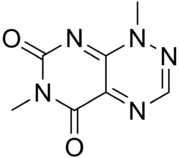Toxoflavin
Toxoflavin is a toxin produced by a variety of bacteria including Burkholderia gladioli. It also has antibiotic properties.[3]
 | |
| Names | |
|---|---|
| IUPAC name
1,6-Dimethylpyrimido[5,4-e][1,2,4]triazine-5,7(1H,6H)-dione | |
| Other names
Toxoflavine; Xanthothricin; Xanthotricin | |
| Identifiers | |
3D model (JSmol) |
|
| ChEBI | |
| ChEMBL | |
| ChemSpider | |
| ECHA InfoCard | 100.213.079 |
PubChem CID |
|
| UNII | |
| |
| |
| Properties | |
| C7H7N5O2 | |
| Molar mass | 193.166 g·mol−1 |
| Appearance | Bright yellow solid |
| Melting point | 172 to 173 °C (342 to 343 °F; 445 to 446 K) (decomposes) |
| Hazards | |
| Lethal dose or concentration (LD, LC): | |
LD50 (median dose) |
1.7 mg/kg (IV, mouse) 8.4 mg/kg (oral, mouse) |
Except where otherwise noted, data are given for materials in their standard state (at 25 °C [77 °F], 100 kPa). | |
| Infobox references | |
Toxoflavin acts as a pH indicator, changing between yellow and colorless at pH 10.5.[1]
References
- Merck Index, 11th Edition, 9480
- Toxoflavin, at the Comparative Toxicogenomics Database
- Machlowitz, Roy A.; Fisher, W. P.; McKay, Betsey S.; Tytell, Alfred A.; Charney, Jesse (1954). "Xanthothricin, a new antibiotic". Antibiotics and Chemotherapy. 4 (3): 259–261. PMID 24542943.
This article is issued from Wikipedia. The text is licensed under Creative Commons - Attribution - Sharealike. Additional terms may apply for the media files.